BMP3004 - Understanding Employee Motivation: Factors & Strategies
VerifiedAdded on 2023/06/05
|7
|1926
|92
Report
AI Summary
This report examines the concept of employee motivation, exploring various factors that influence it, including salary, promotion opportunities, and the work environment. It discusses Maslow's Hierarchy of Needs as a theoretical framework for understanding motivation. The report also analyzes the positive aspects of job roles, such as skill development and modern performance management, alongside negative aspects like toxic work environments and workplace conflicts. Furthermore, it outlines strategies to cope with negative factors, emphasizing the importance of providing opportunities for employees to express opinions and fostering employee engagement. The report concludes that motivation significantly impacts employee performance and organizational success, highlighting the need for organizations to create a positive and supportive work environment.
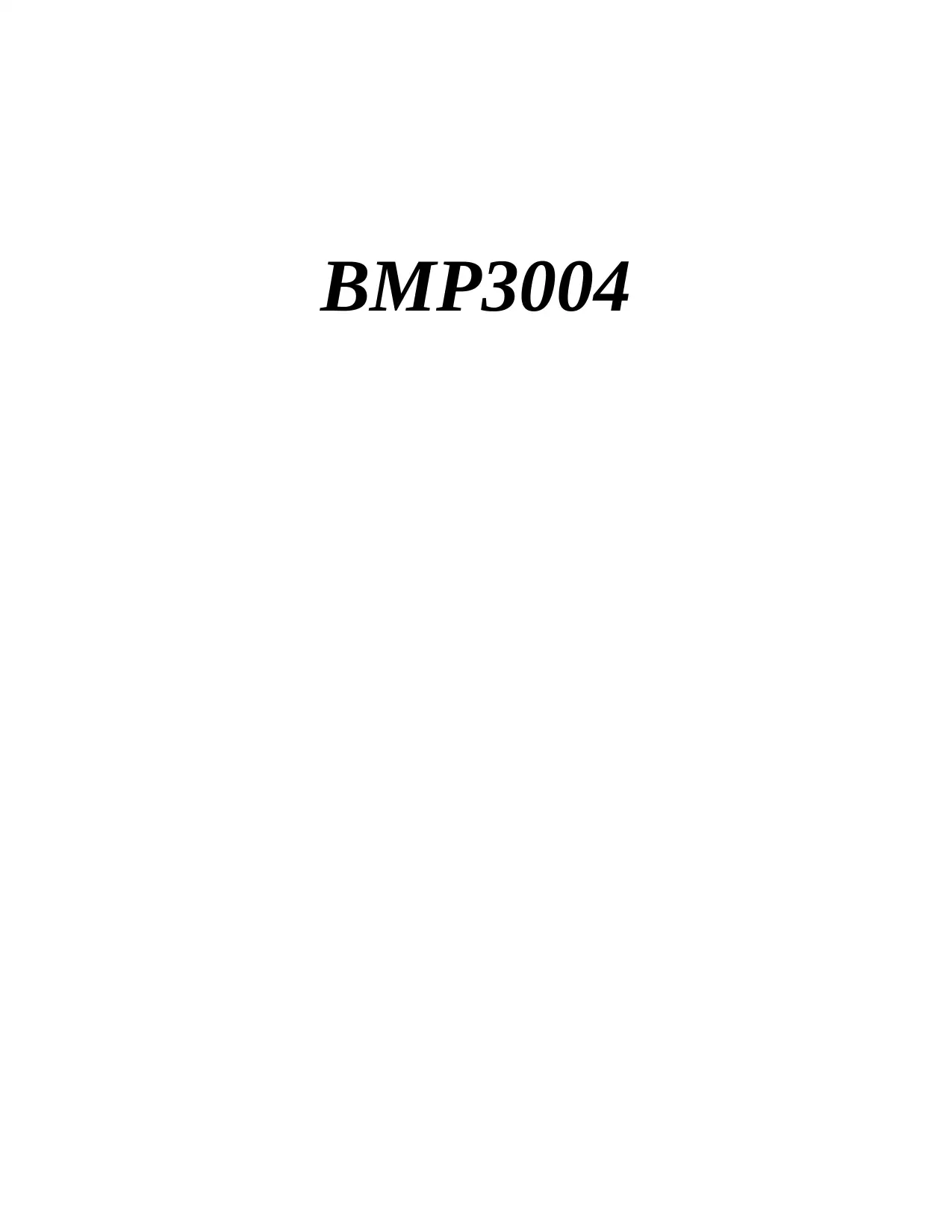
BMP3004
Paraphrase This Document
Need a fresh take? Get an instant paraphrase of this document with our AI Paraphraser
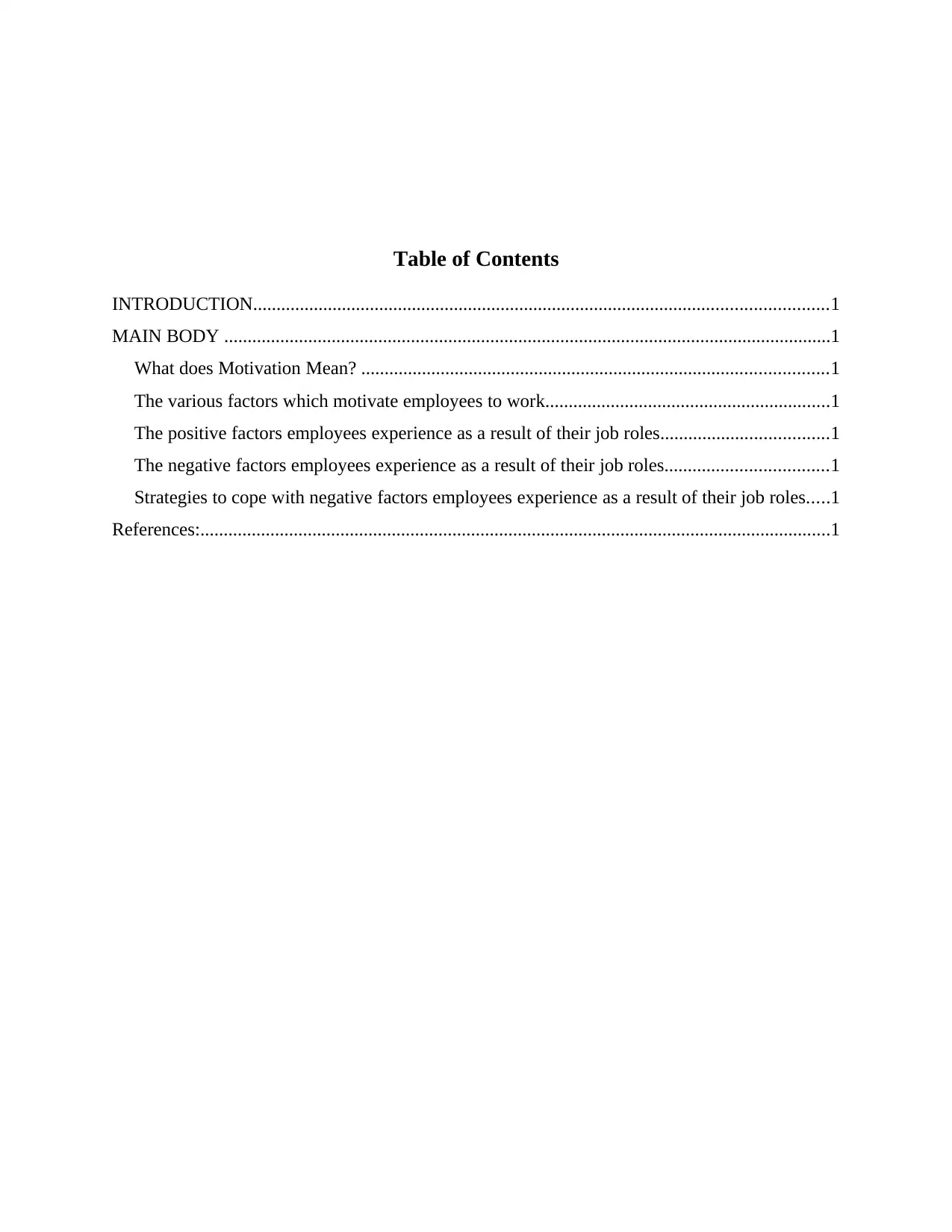
Table of Contents
INTRODUCTION...........................................................................................................................1
MAIN BODY ..................................................................................................................................1
What does Motivation Mean? ....................................................................................................1
The various factors which motivate employees to work.............................................................1
The positive factors employees experience as a result of their job roles....................................1
The negative factors employees experience as a result of their job roles...................................1
Strategies to cope with negative factors employees experience as a result of their job roles.....1
References:.......................................................................................................................................1
INTRODUCTION...........................................................................................................................1
MAIN BODY ..................................................................................................................................1
What does Motivation Mean? ....................................................................................................1
The various factors which motivate employees to work.............................................................1
The positive factors employees experience as a result of their job roles....................................1
The negative factors employees experience as a result of their job roles...................................1
Strategies to cope with negative factors employees experience as a result of their job roles.....1
References:.......................................................................................................................................1
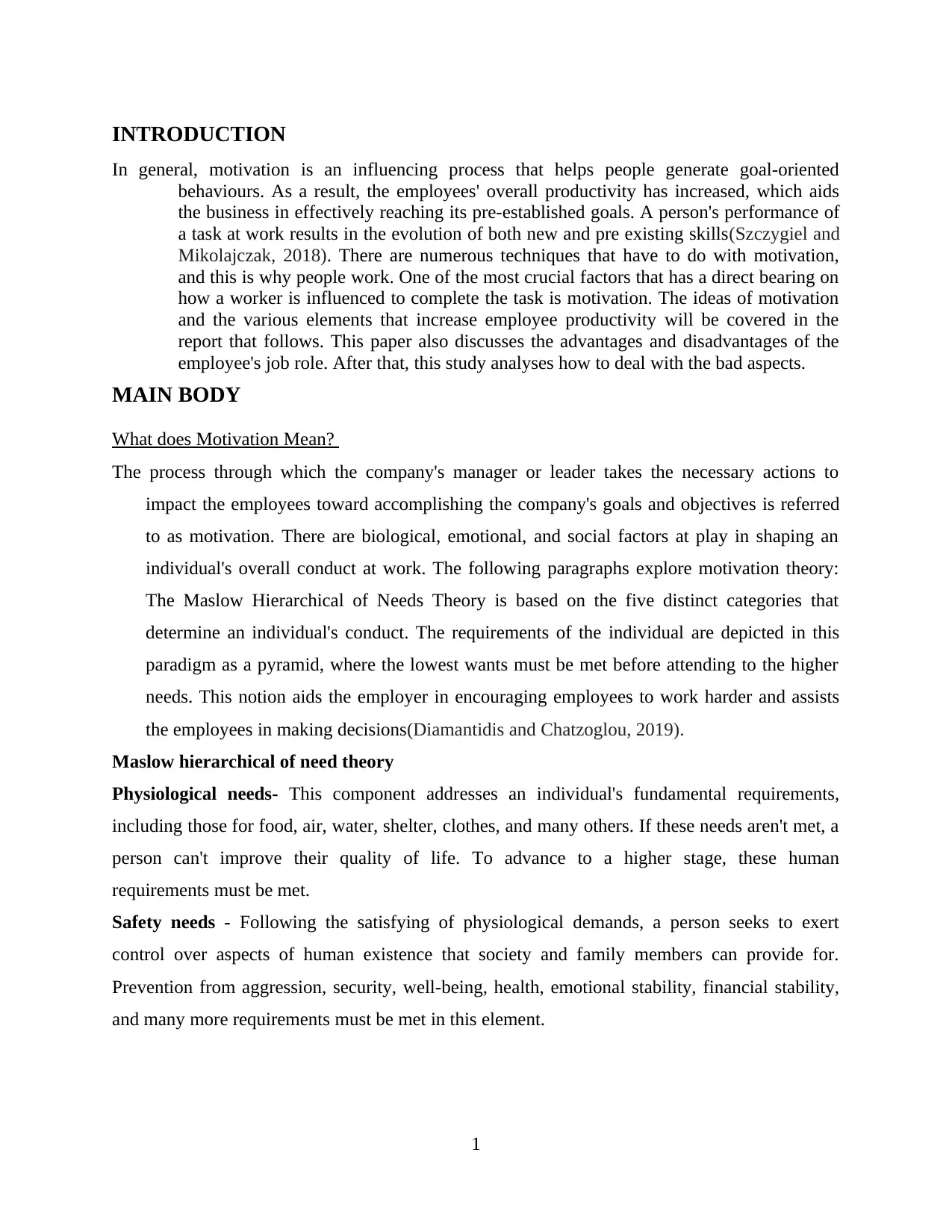
INTRODUCTION
In general, motivation is an influencing process that helps people generate goal-oriented
behaviours. As a result, the employees' overall productivity has increased, which aids
the business in effectively reaching its pre-established goals. A person's performance of
a task at work results in the evolution of both new and pre existing skills(Szczygiel and
Mikolajczak, 2018). There are numerous techniques that have to do with motivation,
and this is why people work. One of the most crucial factors that has a direct bearing on
how a worker is influenced to complete the task is motivation. The ideas of motivation
and the various elements that increase employee productivity will be covered in the
report that follows. This paper also discusses the advantages and disadvantages of the
employee's job role. After that, this study analyses how to deal with the bad aspects.
MAIN BODY
What does Motivation Mean?
The process through which the company's manager or leader takes the necessary actions to
impact the employees toward accomplishing the company's goals and objectives is referred
to as motivation. There are biological, emotional, and social factors at play in shaping an
individual's overall conduct at work. The following paragraphs explore motivation theory:
The Maslow Hierarchical of Needs Theory is based on the five distinct categories that
determine an individual's conduct. The requirements of the individual are depicted in this
paradigm as a pyramid, where the lowest wants must be met before attending to the higher
needs. This notion aids the employer in encouraging employees to work harder and assists
the employees in making decisions(Diamantidis and Chatzoglou, 2019).
Maslow hierarchical of need theory
Physiological needs- This component addresses an individual's fundamental requirements,
including those for food, air, water, shelter, clothes, and many others. If these needs aren't met, a
person can't improve their quality of life. To advance to a higher stage, these human
requirements must be met.
Safety needs - Following the satisfying of physiological demands, a person seeks to exert
control over aspects of human existence that society and family members can provide for.
Prevention from aggression, security, well-being, health, emotional stability, financial stability,
and many more requirements must be met in this element.
1
In general, motivation is an influencing process that helps people generate goal-oriented
behaviours. As a result, the employees' overall productivity has increased, which aids
the business in effectively reaching its pre-established goals. A person's performance of
a task at work results in the evolution of both new and pre existing skills(Szczygiel and
Mikolajczak, 2018). There are numerous techniques that have to do with motivation,
and this is why people work. One of the most crucial factors that has a direct bearing on
how a worker is influenced to complete the task is motivation. The ideas of motivation
and the various elements that increase employee productivity will be covered in the
report that follows. This paper also discusses the advantages and disadvantages of the
employee's job role. After that, this study analyses how to deal with the bad aspects.
MAIN BODY
What does Motivation Mean?
The process through which the company's manager or leader takes the necessary actions to
impact the employees toward accomplishing the company's goals and objectives is referred
to as motivation. There are biological, emotional, and social factors at play in shaping an
individual's overall conduct at work. The following paragraphs explore motivation theory:
The Maslow Hierarchical of Needs Theory is based on the five distinct categories that
determine an individual's conduct. The requirements of the individual are depicted in this
paradigm as a pyramid, where the lowest wants must be met before attending to the higher
needs. This notion aids the employer in encouraging employees to work harder and assists
the employees in making decisions(Diamantidis and Chatzoglou, 2019).
Maslow hierarchical of need theory
Physiological needs- This component addresses an individual's fundamental requirements,
including those for food, air, water, shelter, clothes, and many others. If these needs aren't met, a
person can't improve their quality of life. To advance to a higher stage, these human
requirements must be met.
Safety needs - Following the satisfying of physiological demands, a person seeks to exert
control over aspects of human existence that society and family members can provide for.
Prevention from aggression, security, well-being, health, emotional stability, financial stability,
and many more requirements must be met in this element.
1
⊘ This is a preview!⊘
Do you want full access?
Subscribe today to unlock all pages.

Trusted by 1+ million students worldwide
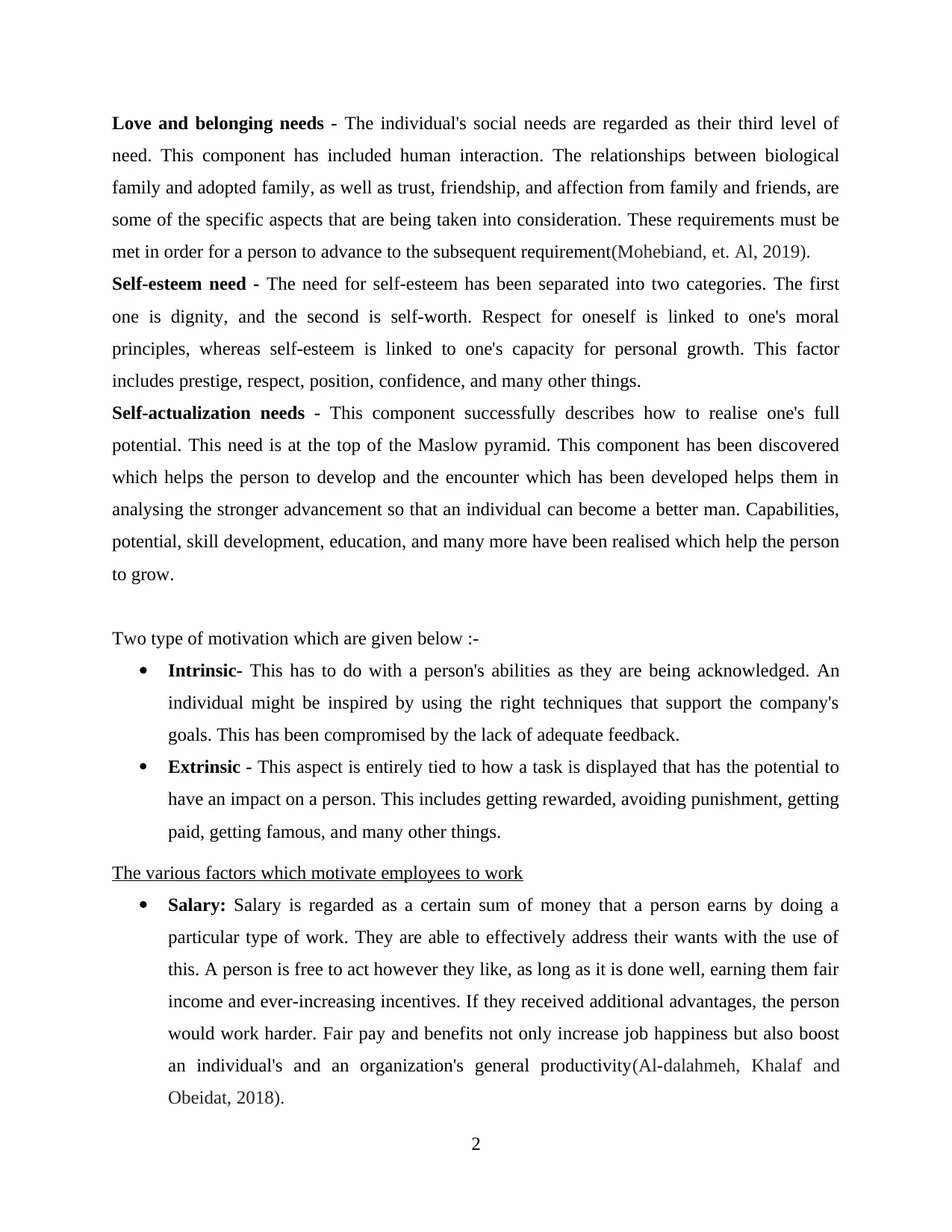
Love and belonging needs - The individual's social needs are regarded as their third level of
need. This component has included human interaction. The relationships between biological
family and adopted family, as well as trust, friendship, and affection from family and friends, are
some of the specific aspects that are being taken into consideration. These requirements must be
met in order for a person to advance to the subsequent requirement(Mohebiand, et. Al, 2019).
Self-esteem need - The need for self-esteem has been separated into two categories. The first
one is dignity, and the second is self-worth. Respect for oneself is linked to one's moral
principles, whereas self-esteem is linked to one's capacity for personal growth. This factor
includes prestige, respect, position, confidence, and many other things.
Self-actualization needs - This component successfully describes how to realise one's full
potential. This need is at the top of the Maslow pyramid. This component has been discovered
which helps the person to develop and the encounter which has been developed helps them in
analysing the stronger advancement so that an individual can become a better man. Capabilities,
potential, skill development, education, and many more have been realised which help the person
to grow.
Two type of motivation which are given below :-
Intrinsic- This has to do with a person's abilities as they are being acknowledged. An
individual might be inspired by using the right techniques that support the company's
goals. This has been compromised by the lack of adequate feedback.
Extrinsic - This aspect is entirely tied to how a task is displayed that has the potential to
have an impact on a person. This includes getting rewarded, avoiding punishment, getting
paid, getting famous, and many other things.
The various factors which motivate employees to work
Salary: Salary is regarded as a certain sum of money that a person earns by doing a
particular type of work. They are able to effectively address their wants with the use of
this. A person is free to act however they like, as long as it is done well, earning them fair
income and ever-increasing incentives. If they received additional advantages, the person
would work harder. Fair pay and benefits not only increase job happiness but also boost
an individual's and an organization's general productivity(Al-dalahmeh, Khalaf and
Obeidat, 2018).
2
need. This component has included human interaction. The relationships between biological
family and adopted family, as well as trust, friendship, and affection from family and friends, are
some of the specific aspects that are being taken into consideration. These requirements must be
met in order for a person to advance to the subsequent requirement(Mohebiand, et. Al, 2019).
Self-esteem need - The need for self-esteem has been separated into two categories. The first
one is dignity, and the second is self-worth. Respect for oneself is linked to one's moral
principles, whereas self-esteem is linked to one's capacity for personal growth. This factor
includes prestige, respect, position, confidence, and many other things.
Self-actualization needs - This component successfully describes how to realise one's full
potential. This need is at the top of the Maslow pyramid. This component has been discovered
which helps the person to develop and the encounter which has been developed helps them in
analysing the stronger advancement so that an individual can become a better man. Capabilities,
potential, skill development, education, and many more have been realised which help the person
to grow.
Two type of motivation which are given below :-
Intrinsic- This has to do with a person's abilities as they are being acknowledged. An
individual might be inspired by using the right techniques that support the company's
goals. This has been compromised by the lack of adequate feedback.
Extrinsic - This aspect is entirely tied to how a task is displayed that has the potential to
have an impact on a person. This includes getting rewarded, avoiding punishment, getting
paid, getting famous, and many other things.
The various factors which motivate employees to work
Salary: Salary is regarded as a certain sum of money that a person earns by doing a
particular type of work. They are able to effectively address their wants with the use of
this. A person is free to act however they like, as long as it is done well, earning them fair
income and ever-increasing incentives. If they received additional advantages, the person
would work harder. Fair pay and benefits not only increase job happiness but also boost
an individual's and an organization's general productivity(Al-dalahmeh, Khalaf and
Obeidat, 2018).
2
Paraphrase This Document
Need a fresh take? Get an instant paraphrase of this document with our AI Paraphraser
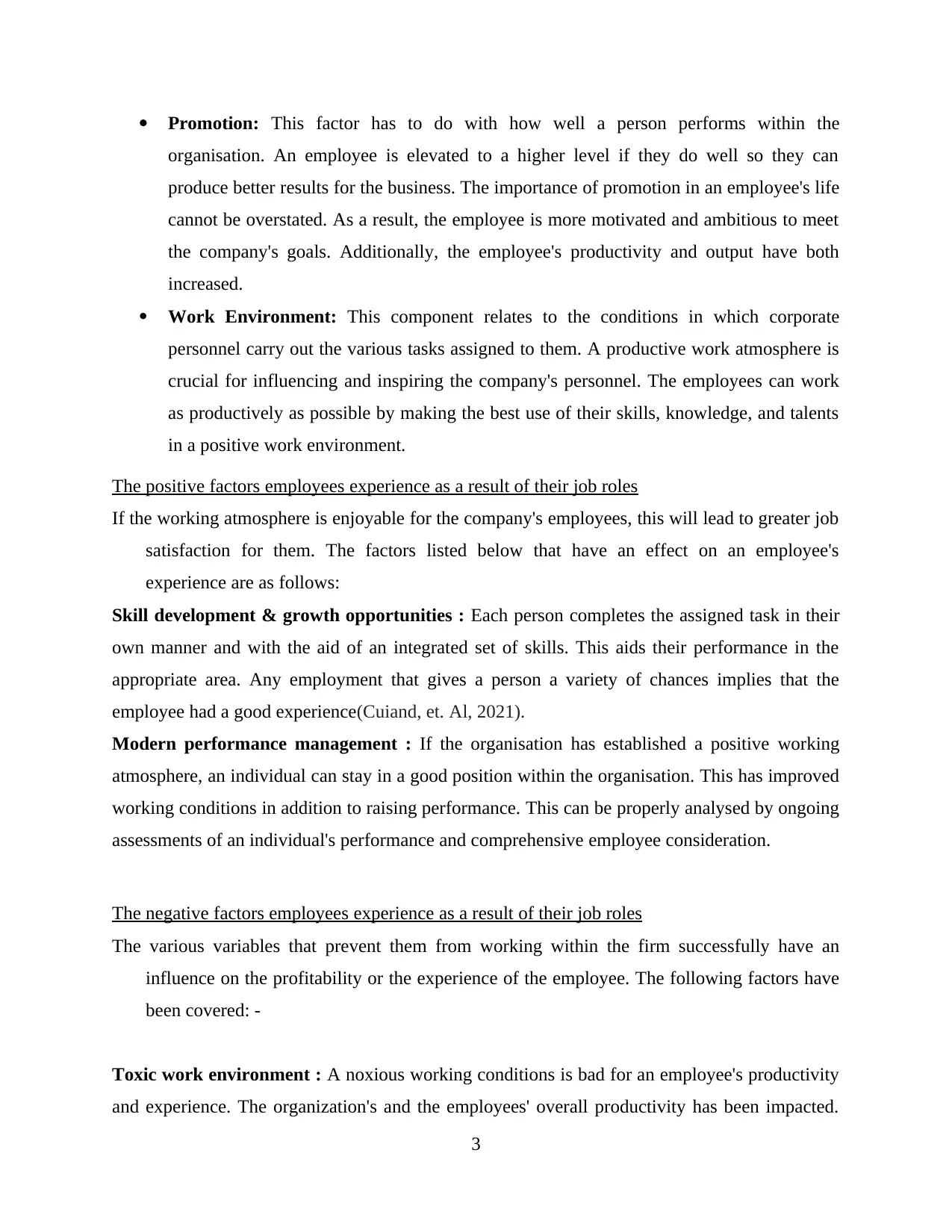
Promotion: This factor has to do with how well a person performs within the
organisation. An employee is elevated to a higher level if they do well so they can
produce better results for the business. The importance of promotion in an employee's life
cannot be overstated. As a result, the employee is more motivated and ambitious to meet
the company's goals. Additionally, the employee's productivity and output have both
increased.
Work Environment: This component relates to the conditions in which corporate
personnel carry out the various tasks assigned to them. A productive work atmosphere is
crucial for influencing and inspiring the company's personnel. The employees can work
as productively as possible by making the best use of their skills, knowledge, and talents
in a positive work environment.
The positive factors employees experience as a result of their job roles
If the working atmosphere is enjoyable for the company's employees, this will lead to greater job
satisfaction for them. The factors listed below that have an effect on an employee's
experience are as follows:
Skill development & growth opportunities : Each person completes the assigned task in their
own manner and with the aid of an integrated set of skills. This aids their performance in the
appropriate area. Any employment that gives a person a variety of chances implies that the
employee had a good experience(Cuiand, et. Al, 2021).
Modern performance management : If the organisation has established a positive working
atmosphere, an individual can stay in a good position within the organisation. This has improved
working conditions in addition to raising performance. This can be properly analysed by ongoing
assessments of an individual's performance and comprehensive employee consideration.
The negative factors employees experience as a result of their job roles
The various variables that prevent them from working within the firm successfully have an
influence on the profitability or the experience of the employee. The following factors have
been covered: -
Toxic work environment : A noxious working conditions is bad for an employee's productivity
and experience. The organization's and the employees' overall productivity has been impacted.
3
organisation. An employee is elevated to a higher level if they do well so they can
produce better results for the business. The importance of promotion in an employee's life
cannot be overstated. As a result, the employee is more motivated and ambitious to meet
the company's goals. Additionally, the employee's productivity and output have both
increased.
Work Environment: This component relates to the conditions in which corporate
personnel carry out the various tasks assigned to them. A productive work atmosphere is
crucial for influencing and inspiring the company's personnel. The employees can work
as productively as possible by making the best use of their skills, knowledge, and talents
in a positive work environment.
The positive factors employees experience as a result of their job roles
If the working atmosphere is enjoyable for the company's employees, this will lead to greater job
satisfaction for them. The factors listed below that have an effect on an employee's
experience are as follows:
Skill development & growth opportunities : Each person completes the assigned task in their
own manner and with the aid of an integrated set of skills. This aids their performance in the
appropriate area. Any employment that gives a person a variety of chances implies that the
employee had a good experience(Cuiand, et. Al, 2021).
Modern performance management : If the organisation has established a positive working
atmosphere, an individual can stay in a good position within the organisation. This has improved
working conditions in addition to raising performance. This can be properly analysed by ongoing
assessments of an individual's performance and comprehensive employee consideration.
The negative factors employees experience as a result of their job roles
The various variables that prevent them from working within the firm successfully have an
influence on the profitability or the experience of the employee. The following factors have
been covered: -
Toxic work environment : A noxious working conditions is bad for an employee's productivity
and experience. The organization's and the employees' overall productivity has been impacted.
3
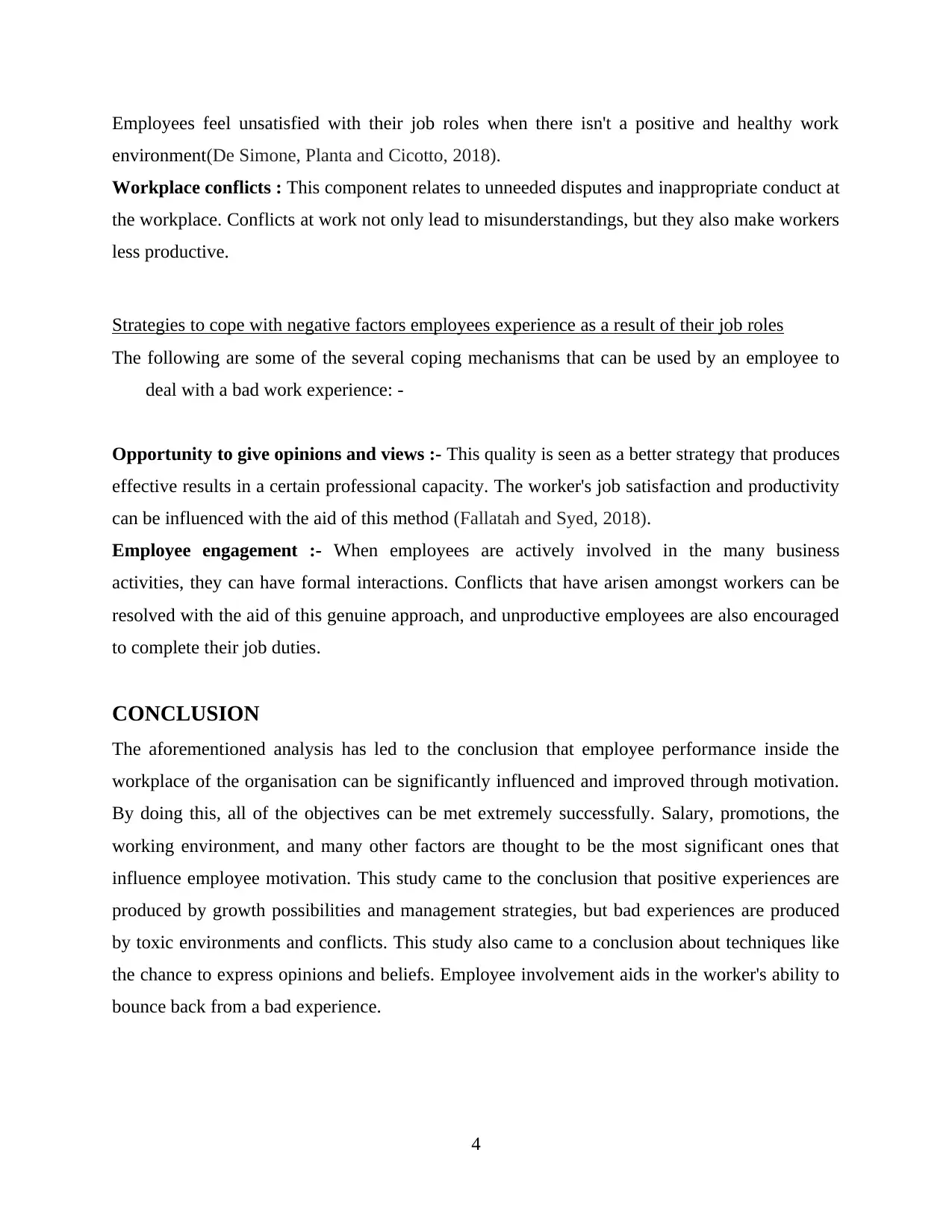
Employees feel unsatisfied with their job roles when there isn't a positive and healthy work
environment(De Simone, Planta and Cicotto, 2018).
Workplace conflicts : This component relates to unneeded disputes and inappropriate conduct at
the workplace. Conflicts at work not only lead to misunderstandings, but they also make workers
less productive.
Strategies to cope with negative factors employees experience as a result of their job roles
The following are some of the several coping mechanisms that can be used by an employee to
deal with a bad work experience: -
Opportunity to give opinions and views :- This quality is seen as a better strategy that produces
effective results in a certain professional capacity. The worker's job satisfaction and productivity
can be influenced with the aid of this method (Fallatah and Syed, 2018).
Employee engagement :- When employees are actively involved in the many business
activities, they can have formal interactions. Conflicts that have arisen amongst workers can be
resolved with the aid of this genuine approach, and unproductive employees are also encouraged
to complete their job duties.
CONCLUSION
The aforementioned analysis has led to the conclusion that employee performance inside the
workplace of the organisation can be significantly influenced and improved through motivation.
By doing this, all of the objectives can be met extremely successfully. Salary, promotions, the
working environment, and many other factors are thought to be the most significant ones that
influence employee motivation. This study came to the conclusion that positive experiences are
produced by growth possibilities and management strategies, but bad experiences are produced
by toxic environments and conflicts. This study also came to a conclusion about techniques like
the chance to express opinions and beliefs. Employee involvement aids in the worker's ability to
bounce back from a bad experience.
4
environment(De Simone, Planta and Cicotto, 2018).
Workplace conflicts : This component relates to unneeded disputes and inappropriate conduct at
the workplace. Conflicts at work not only lead to misunderstandings, but they also make workers
less productive.
Strategies to cope with negative factors employees experience as a result of their job roles
The following are some of the several coping mechanisms that can be used by an employee to
deal with a bad work experience: -
Opportunity to give opinions and views :- This quality is seen as a better strategy that produces
effective results in a certain professional capacity. The worker's job satisfaction and productivity
can be influenced with the aid of this method (Fallatah and Syed, 2018).
Employee engagement :- When employees are actively involved in the many business
activities, they can have formal interactions. Conflicts that have arisen amongst workers can be
resolved with the aid of this genuine approach, and unproductive employees are also encouraged
to complete their job duties.
CONCLUSION
The aforementioned analysis has led to the conclusion that employee performance inside the
workplace of the organisation can be significantly influenced and improved through motivation.
By doing this, all of the objectives can be met extremely successfully. Salary, promotions, the
working environment, and many other factors are thought to be the most significant ones that
influence employee motivation. This study came to the conclusion that positive experiences are
produced by growth possibilities and management strategies, but bad experiences are produced
by toxic environments and conflicts. This study also came to a conclusion about techniques like
the chance to express opinions and beliefs. Employee involvement aids in the worker's ability to
bounce back from a bad experience.
4
⊘ This is a preview!⊘
Do you want full access?
Subscribe today to unlock all pages.

Trusted by 1+ million students worldwide
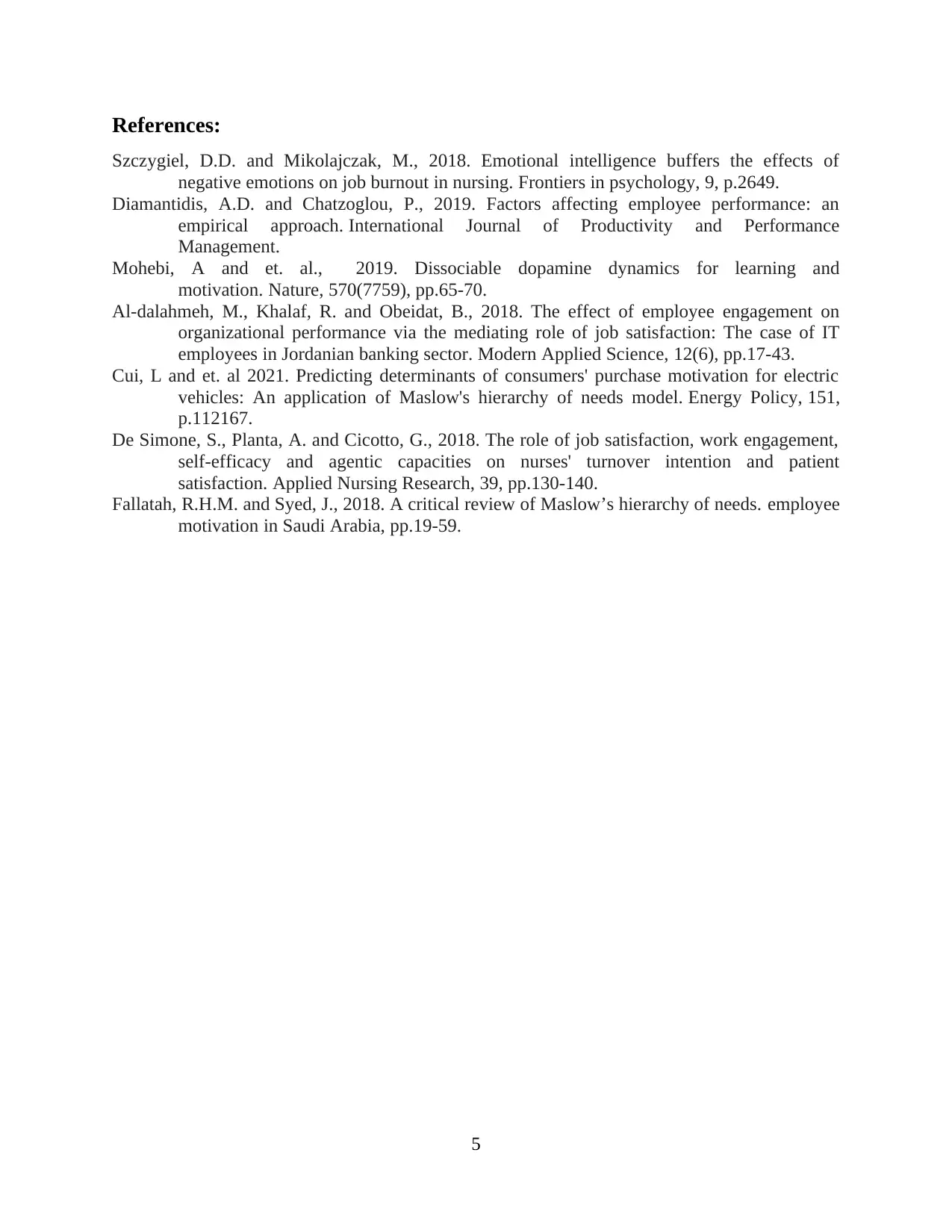
References:
Szczygiel, D.D. and Mikolajczak, M., 2018. Emotional intelligence buffers the effects of
negative emotions on job burnout in nursing. Frontiers in psychology, 9, p.2649.
Diamantidis, A.D. and Chatzoglou, P., 2019. Factors affecting employee performance: an
empirical approach. International Journal of Productivity and Performance
Management.
Mohebi, A and et. al., 2019. Dissociable dopamine dynamics for learning and
motivation. Nature, 570(7759), pp.65-70.
Al-dalahmeh, M., Khalaf, R. and Obeidat, B., 2018. The effect of employee engagement on
organizational performance via the mediating role of job satisfaction: The case of IT
employees in Jordanian banking sector. Modern Applied Science, 12(6), pp.17-43.
Cui, L and et. al 2021. Predicting determinants of consumers' purchase motivation for electric
vehicles: An application of Maslow's hierarchy of needs model. Energy Policy, 151,
p.112167.
De Simone, S., Planta, A. and Cicotto, G., 2018. The role of job satisfaction, work engagement,
self-efficacy and agentic capacities on nurses' turnover intention and patient
satisfaction. Applied Nursing Research, 39, pp.130-140.
Fallatah, R.H.M. and Syed, J., 2018. A critical review of Maslow’s hierarchy of needs. employee
motivation in Saudi Arabia, pp.19-59.
5
Szczygiel, D.D. and Mikolajczak, M., 2018. Emotional intelligence buffers the effects of
negative emotions on job burnout in nursing. Frontiers in psychology, 9, p.2649.
Diamantidis, A.D. and Chatzoglou, P., 2019. Factors affecting employee performance: an
empirical approach. International Journal of Productivity and Performance
Management.
Mohebi, A and et. al., 2019. Dissociable dopamine dynamics for learning and
motivation. Nature, 570(7759), pp.65-70.
Al-dalahmeh, M., Khalaf, R. and Obeidat, B., 2018. The effect of employee engagement on
organizational performance via the mediating role of job satisfaction: The case of IT
employees in Jordanian banking sector. Modern Applied Science, 12(6), pp.17-43.
Cui, L and et. al 2021. Predicting determinants of consumers' purchase motivation for electric
vehicles: An application of Maslow's hierarchy of needs model. Energy Policy, 151,
p.112167.
De Simone, S., Planta, A. and Cicotto, G., 2018. The role of job satisfaction, work engagement,
self-efficacy and agentic capacities on nurses' turnover intention and patient
satisfaction. Applied Nursing Research, 39, pp.130-140.
Fallatah, R.H.M. and Syed, J., 2018. A critical review of Maslow’s hierarchy of needs. employee
motivation in Saudi Arabia, pp.19-59.
5
1 out of 7
Related Documents
Your All-in-One AI-Powered Toolkit for Academic Success.
+13062052269
info@desklib.com
Available 24*7 on WhatsApp / Email
![[object Object]](/_next/static/media/star-bottom.7253800d.svg)
Unlock your academic potential
Copyright © 2020–2025 A2Z Services. All Rights Reserved. Developed and managed by ZUCOL.


